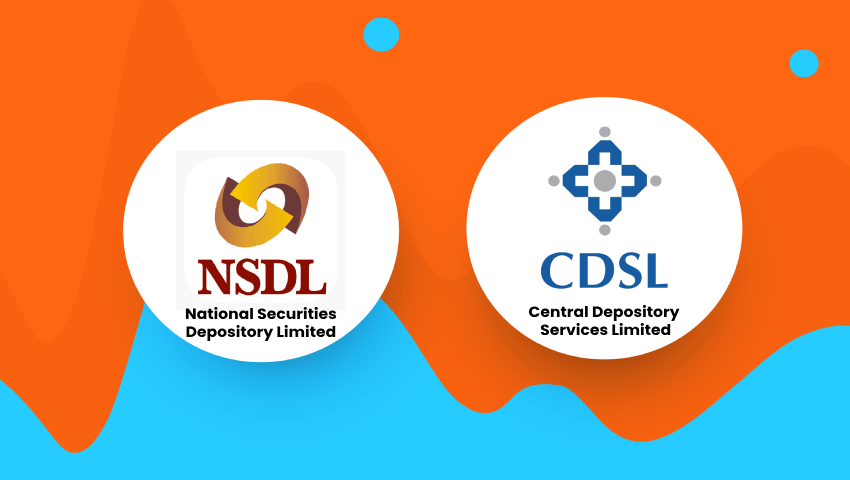
- 07/06/2025
- MyFinanceGyan
- 585 Views
- 2 Likes
- Share Market
CDSL vs NSDL: Who Holds the Edge in India’s Depository Race?
In India, opening a Demat account is a mandatory step for investing in the stock market. Two major institutions — National Securities Depository Limited (NSDL) and Central Depository Services Limited (CDSL) — offer these services. While both depositories perform similar functions, they differ in structure, affiliations, and certain features. In this article, we compare CDSL vs NSDL to help you make an informed choice.
What is NSDL?
National Securities Depository Limited (NSDL) was established in 1996 as India’s first depository. It was promoted by the National Stock Exchange (NSE) and backed by financial giants like IDBI Bank, State Bank of India, Unit Trust of India, and HDFC Bank. As of February 29, 2024, NSDL had over 3.54 crore active Demat accounts.
What is CDSL?
Central Depository Services Limited (CDSL) was launched in 1999 by the Bombay Stock Exchange (BSE), with backing from major banks such as Bank of India, SBI, HDFC Bank, Bank of Baroda, and LIC of India. CDSL became the first depository in India to cross 5 crore Demat accounts in 2021 and now boasts over 11.27 crore active accounts.
Key Features of NSDL and CDSL:
Both depositories offer:
- Dematerialisation and rematerialisation of securities
- Electronic transfer of shares
- E-voting for shareholder participation
- Pledging of securities for loans and leverage
- Secure and regulated settlement of trades
NSDL vs CDSL – Tabular Comparison:
Services Offered by Both NSDL and CDSL:
Dematerialisation & Rematerialisation:
- Demat: Converts physical share certificates into electronic form.
- Remat: Converts electronic securities back into physical form, if required.
Demat Account Management:
- Opening, maintaining, and updating of electronic securities accounts.
- Periodic account statements.
Trade Settlement:
- Facilitates smooth electronic transfer of securities post-trade.
Corporate Actions:
- Disburses dividends, bonuses, rights, splits, etc., directly to investors.
Pledge Services:
- Enables investors to pledge shares as collateral for loans or margin funding.
E-voting Facility:
- Offers secure, digital voting for company shareholders.
Additional Services Offered:
NSDL Exclusive Services:
- National Academic Depository (NAD): Stores academic certificates securely.
- Tax Information Network (TIN): Manages PAN, TDS, and TCS-related data.
CDSL Exclusive Services:
- Commodity Repository: Manages electronic warehouse receipts.
- e-Locker: Secure digital document storage.
- KYC Services: Through CDSL Ventures Ltd (CVL) for investor verification.
Which is Better: NSDL or CDSL?
While both NSDL and CDSL are regulated by the Securities and Exchange Board of India (SEBI) and offer nearly identical services, here’s what you should consider:
- Affiliation: If you’re trading primarily on NSE, NSDL might be preferred. For BSE, CDSL could be ideal.
- Demat Account Numbers: CDSL offers 16-digit numeric IDs, while NSDL uses a 14-digit format prefixed with “IN”.
- Market Presence: CDSL leads in the number of active Demat accounts, indicating stronger outreach.
Ultimately, the choice boils down to personal preference or the broker’s affiliation. Most brokers provide access to both.
Final Thoughts:
The Central Depository Services Limited (CDSL) and the National Securities Depository Limited (NSDL) are the backbones of India’s digital securities infrastructure. They have made trading seamless, transparent, and efficient. Whether you choose NSDL or CDSL, your investments remain safe, secure, and governed by robust regulations.
FAQs:
A depository holds your securities in an electronic (Demat) form and facilitates their trading.
Both are regulated by SEBI and are equally safe.
Yes, you can hold Demat accounts with both depositories via different brokers.
Yes, charges may differ based on the broker you choose. Compare brokerage fees before deciding.
As of February 2024, CDSL leads with 11.27 crore+ accounts, compared to 3.54 crore+ under NSDL.
Disclaimer:
The views in the article/blog are personal and that of the author. This content is meant solely for educational purposes and is not intended as financial advice or a product recommendation.



